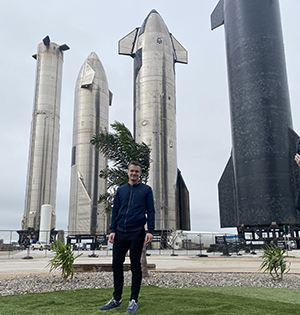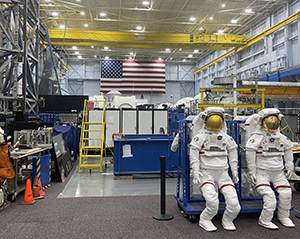
3D printing for aerospace: two areas in particular are developing
It is not only in connection with research that the aerospace industry is gaining momentum - it is also happening through large commercial companies. On a network trip to Houston with some of the aerospace industry's big players, the Danish Technological Institute saw the important role that 3D printing plays in development - particularly in two areas.

Boeing, NASA, and Jacobs - but also SpaceX and Amazon's Blue Origin - are all helping to develop the aerospace industry. More and more people want to join the space journey, and 3D printing is also onboard.
Senior Project Manager within 3D printing at the Danish Technological Institute, Anders Hjermitslev, has experienced 3D printing's role in development up close. On a recent trip to the US, which was organized by the Ministry of Education and Research, he had the opportunity to learn more about the aerospace industry and establish contact with American companies, together with selected Danish companies, knowledge institutions and universities.
With visits to NASA's Johnson Space Center, Boeing, SpaceX, and universities in Houston, Anders Hjermitslev was able to discuss the Danish Technological Institute's current aerospace projects - and gain an insight into the growing role that 3D printing plays in the development of this industry.
3D printing can optimize rocket engines and satellites
3D printing helps make space travel even better.
A large part of the aerospace industry is about manufacturing engines and satellites, and this is exactly where 3D printing can contribute - when an engine needs to be manufactured, a rocket nozzle needs to be produced, and various components that need to deliver fuel must be assembled. Anders Hjermitslev experienced this during the trip to Houston.
Rocket engines in particular are going through an enormous development. It seems like roughly 50 percent of the components used to make engines are 3D printed. And 3D printing is also used a lot in satellites and antennas
- Anders Hjermitslev, Danish Technological Institute
It is no coincidence that 3D printing is used to a great extent for precisely rocket engines, satellites, and antennas.
- There is extra design freedom in 3D printing, so it is possible to make internal cooling channels and integrate many components in one. Antennas are also quite complex in relation to the design, and here 3D printing can be designed more compactly and more easily, says Anders Hjermitslev.
Heavy duty parts are also an area where 3D printing can help develop the space industry with its lighter components, fewer joining surfaces, and variety of materials.
The Danish Technological Institute is developing aerospace industry

The Danish Technological Institute is involved in a project in the aerospace industry, which Anders Hjermitslev presented and got sparring on during the US trip. The project is about a smart skin with a 3D-printed structure, which must be pulled over various robotic arms on the International Space Station. This new skin will make it easier for astronauts to interact with the robotic arms and protect them in the event of a collision.
- We have to create a structure that is a little softer. It will be 3D-printed, and then there will be sensors on the outside. That way it is easier to program the robot and minimize the risk of the robot causing damage if it hits something, says Anders Hjermitslev.
It is the European Space Agency (ESA), which organizes space travel in Europe, who has hired the Danish Technological Institute for further development of the project.
In addition to this current project, antennas are an area that the Danish Technological Institute is looking into with the aim of making 3D prints together with future partners. The Institute has already 3D-printed antennas that are used on the ground, but the principle and design freedom are the same, and with the Danish Technological Institute's equipment it will be easily transferable to aerospace projects.
3D printing for space and in space
3D printing's role in developing rocket engines, satellites, and antennas is particularly linked to one of two areas, and that is 3D printing that is made for space. The Danish Technological Institute is already contributing to this development and would like to make even more 3D prints of antennas and rocket engines for space applications.
The other area of development is printing in space. This is newer, but it is also being looked into more closely in the aerospace industry.
There are a number of activities where you look at printing in space. This means that you could have a 3D printer on e.g. the International Space Station. This is relevant if you are up there and need things that would otherwise be very expensive to send up
- Anders Hjermitslev, Danish Technological Institute
Having 3D printers in space is something that is being looked into for the future where humans will potentially be able to live on Mars. Among other things, Anders Hjermitslev mentions that this autumn, Andreas Mogensen will test a metal 3D printer on the International Space Station during his next mission.
The development with 3D printing for the aerospace industry is therefore one that will continue far into the future. You could even say “To infinity … and beyond!”